
Employers Can Help Impacted Employees on the Emotional Journey
Losing a job hurts. In this pandemic era, this painful toll of job loss is widespread, as more than 30 million Americans have filed for unemployment since the coronavirus began crushing the U.S. job market. For the impacted employee, the present global crisis can further compound the challenges and stresses felt.
As one of life’s most stressful events, job loss has profound effects on a person’s emotional well-being. In fact, it regularly follows the typical stages of grief: 1. Denial and Isolation, 2. Anger, 3. Bargaining, 4. Depression, and 5. Acceptance (Kübler-Ross model).
Everyone experiences grief differently, as many may not experience the stages in the order listed above or to the same degree. A survey by Waldron, a Seattle-headquartered talent & career management firm, corroborated these differences in emotions of people dismissed from work, either through reduction-in-force (RIF) or termination. The research indicates that while empathetic business leaders and HR professionals may not be able to eliminate such grieving-related emotions of impacted employees, they can help.
 The Road to Acceptance
The Road to Acceptance
Moving from the negative emotions of job loss to the forward momentum of a job search requires successfully navigating grief to and through acceptance. Reaching such a destination on the emotional journey is not a given; thus, direct effort, support, and a plan aid greatly to increase an individual’s progress. Dealing with the emotional aspects of losing a job can keep people from moving forward. It is important the emotional issues are processed so significant practical matters can be productively addressed toward next steps.
Within the survey of 336 participants, acceptance was the emotion most felt at the time of their dismissal. However, feelings of anger ranked a close second, followed by depression. Generally, respondents did not display a great deal of denial or bargaining, rating both below the midpoint of three (1 = feeling not at all, 5 = feeling a great deal).
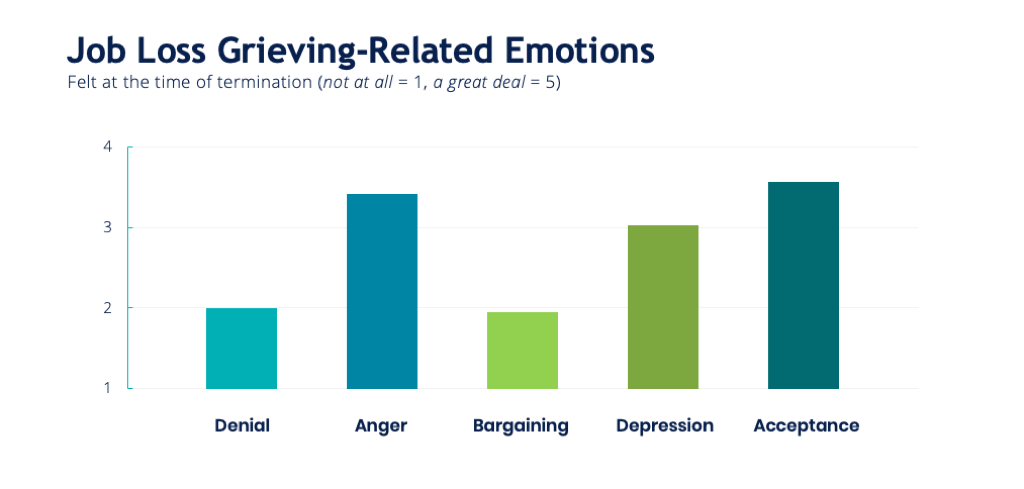 The negative grief-related emotions are easy to understand, as a significant part of one’s life disappears when a job is lost. People often closely identify themselves by what they do. Thus, a job loss can be a real blow to one’s self-image, creating a loss of both identity and purpose. Even if a person did not love their job, it represents the loss of a social outlet, structure, and financial security or comfort. Suddenly finding oneself out of work can leave a person feeling hurt, angry, or depressed.
The negative grief-related emotions are easy to understand, as a significant part of one’s life disappears when a job is lost. People often closely identify themselves by what they do. Thus, a job loss can be a real blow to one’s self-image, creating a loss of both identity and purpose. Even if a person did not love their job, it represents the loss of a social outlet, structure, and financial security or comfort. Suddenly finding oneself out of work can leave a person feeling hurt, angry, or depressed.
The circumstances of a dismissal certainly play a role in both the negative emotions and feelings of acceptance. Additionally, Waldron’s survey found that support, such as career transition and outplacement services, provided to the departing employee makes a difference in levels of acceptance at the time of notification and beyond. Survey participants who used career transition/outplacement services had a higher level of acceptance than those who did not or who were not offered this support. This higher acceptance pattern is particularly pronounced among people who were let go individually.
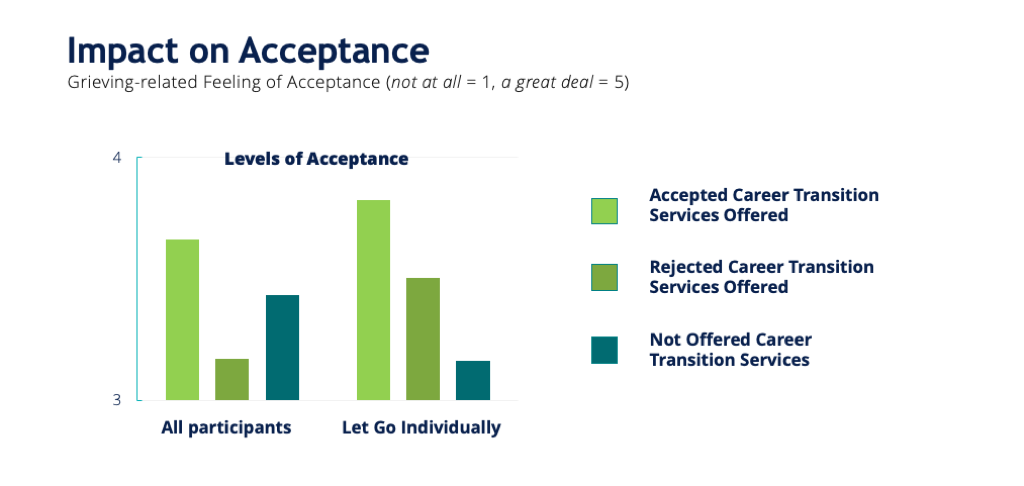
Beyond the myriad of factors which impact an employee’s job satisfaction and, thus, their feelings about their employer up to the point of dismissal, acceptance and other grieving-related emotions were also affected by whether advance notice and/or full explanations were given.

Advance Notice Reduces Feelings of Anger
Whenever possible, providing advance notice is beneficial to both the impacted employee(s) and the employer. Survey participants who were given advance notice were significantly less angry than those who had some notice and those who had no notice.
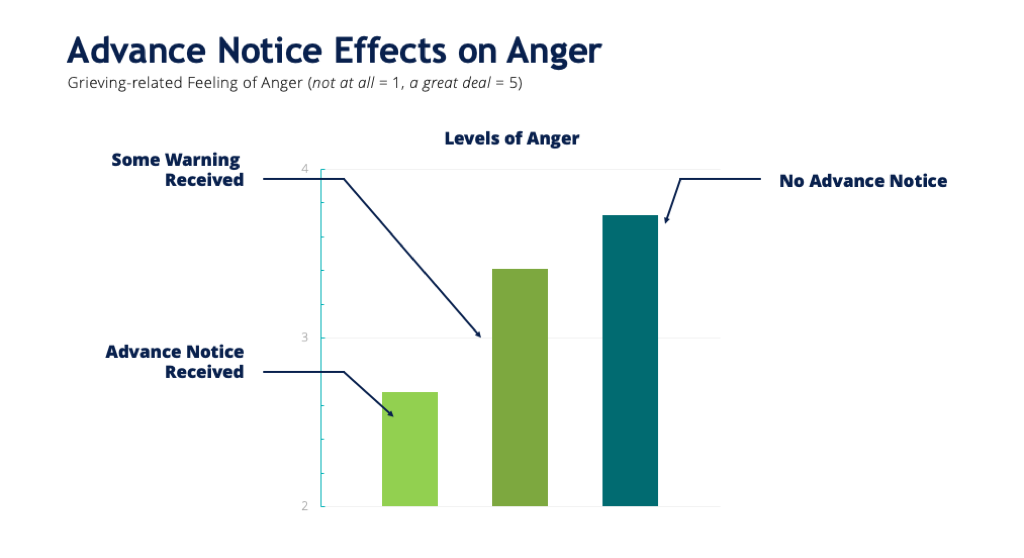
Full Explanations Given Increase Feelings of Acceptance
Within the survey, how satisfactory an explanation people received had a significant effect on how much they felt acceptance of their job loss. Those who were given full explanations showed the highest level of acceptance, followed by those who were given some explanation. The lowest level of acceptance was among those who felt they were given no explanation at all.
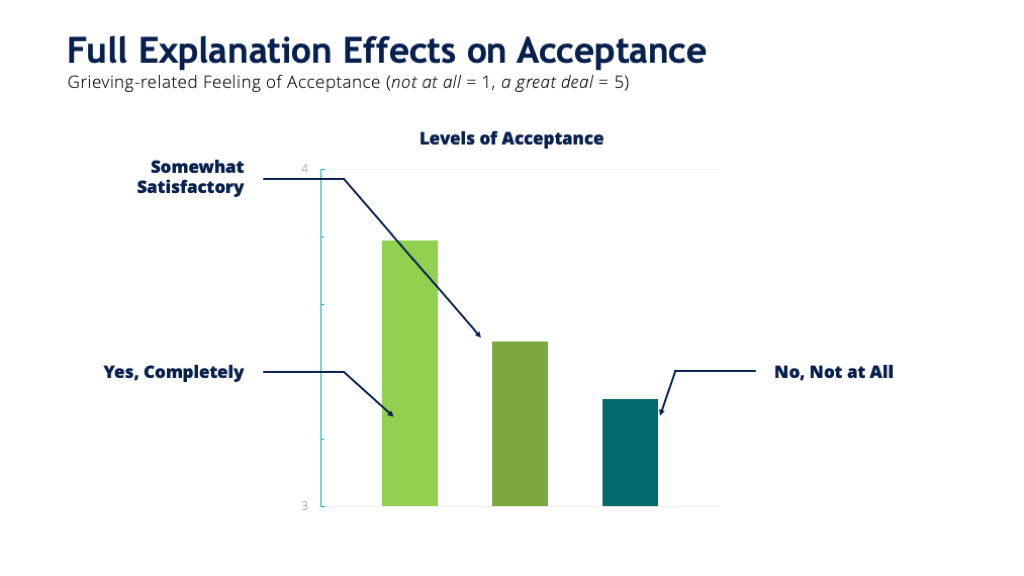
Explanation Lowers Negative Grief-Related Emotions
Conversely, the research suggested that explanation had a significant effect on decreasing other grief-related emotions (denial, anger, bargaining, and depression). In fact, all were significantly impacted by the presence of a full explanation. People who were given full explanations reported the lowest levels of denial, anger, bargaining, and depression.
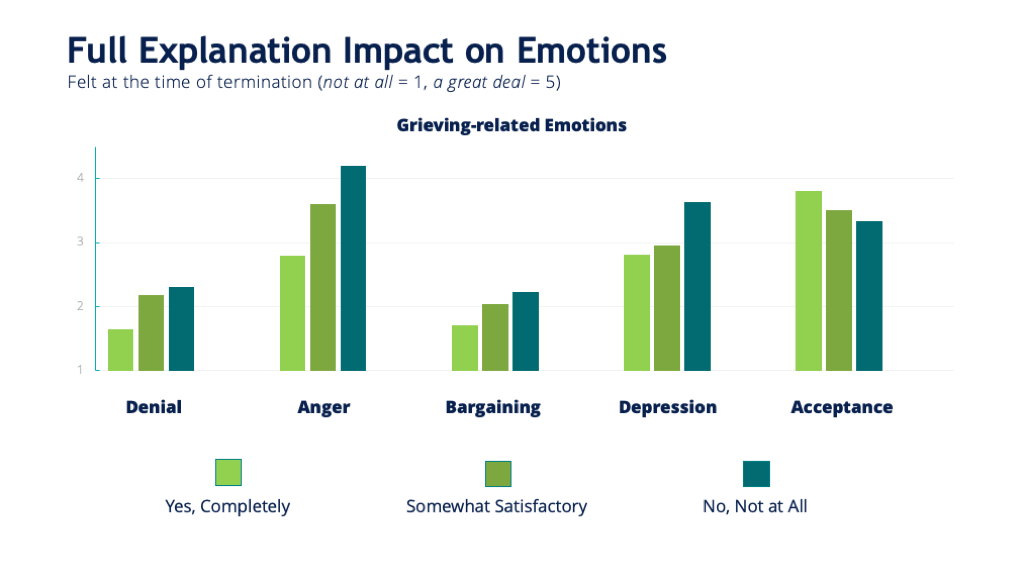
Though advance notifications and full explanations are not always possible, quality notification meetings at the time of dismissal are critically important to doing it the right way and compassionately. Toward assisting in these individual and group meetings, Waldron offers their free resource for download, Manager’s Guide to Conducting Notification Meetings.
When it comes to acceptance, only two things gave some level of prediction: being provided an explanation and using career transition or outplacement services. Both of these had positive and nearly significant unique effects on the degree to which people felt acceptance about their termination. Whereas, advanced notice, job loss type, and message delivery type did not have significant unique effects on feelings of acceptance.
How Career Transition and Outplacement Services Help
For the impacted employee, career transition services provide invaluable support and coaching to ease the stress and emotions associated with a job loss. The presence of outplacement service benefits can give some level of security and comfort at the point of notification. However, it is accepting and using this career transition expertise that makes the biggest difference. Contacting a career transition coach can be the first step of acceptance, looking forward, and setting a path for the future. Outplacement services help participants:
- Create a career strategy based on assessments and career exploration tools
- Develop and/or sharpen job search materials, such as resume and LinkedIn profile
- Craft personal branding
- Research ideal positions and employers
- Network effectively
- Interview successfully
- Negotiate and evaluate job offers
For employers, the use of career transition services is noted by the impacted employees, remaining employees, and the communities an organization operates within. Offering such services goes a long way in reinforcing an organization’s good reputation among employees, customers, and key stakeholders. Beyond the benefit to impacted employees listed above, career transition and outplacement services serve the employer by:
- Increasing loyalty, satisfaction, and morale of remaining employees
- Maintaining remaining employees’ engagement and productivity
- Safeguarding the organization’s reputation with employees and its community
- Decreasing risks of lawsuit claims
- Recruiting and retaining top talent
![]() Click here to download a PDF of this article.
Click here to download a PDF of this article.
If you're interested to learn more, read our previous article on this topic, The Emotional Journey of a Job Loss.
About Waldron CPI Career Transition Services
Waldron CPI views service support through two lenses: 1) the experience of impacted individuals using career transition services, and 2) the organization’s lens and the experience of HR team members and business leaders responsible for outplacement/career transition services.
Waldron CPI’s career transition/outplacement services promise and deliver a high-touch, personalized experience for each employee. Departing employees assess several alternatives for their next professional experience—including re-employment, flexible work arrangements, part-time or contract employment, consulting, entrepreneurial endeavors, or retirement.
Contact us to learn about Waldron CPI’s industry-leading results. The results help organizations optimize return on investment in offering exceptional career transition services, including reduction-in-force (RIF) planning and manager notification training.
